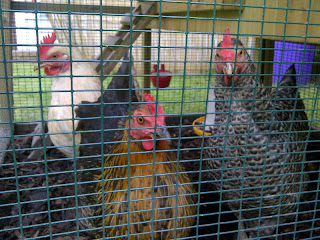6am Saturday morning, I was up, and having let the chickens out of their house and into their run I was settling down to my morning routine.
About half an hour later I could hear a little noise from the chickens, but this is not uncommon when they are laying. Em however, who is far more observant when it comes to the various noises they make, was stirred from sleep upstairs... the next thing I knew, Em shouted 'MATT! FOX! IT'S A FOX! GET OUT THERE!'.
.JPG) |
| Benny chicken - one of our three hens |
I remember when we first got our chickens over a year ago, we were super aware of the threat posed by foxes; but as the year has passed, we had not seen any nearby and believed that because we live in the middle of an island of houses whose gardens back onto each other, that a fox would not be able to reach our chooks... we know better now.
After Em's alarm-raising shouts, the fox cleared three low fences along our row of houses and disappeared. I didn't see it myself, but Em said it was a big one - it looked as though it had already caught something and was making off with it... thankfully all our chickens were left slightly startled, but unharmed.
So - a plan of action was required! We decided that we would move the chickens from the back of the garden (which is more overgrown) to much closer to the house. Our garden is about 60ft long, so they weren't that far away - but our hope is that foxes will be far more reluctant to come right up close to our house.
We have a really decent chicken house with built in run that we got from Flyte So Fancy, who also supply the egg boxes that we use to sell the chicken's eggs outside our house 50p for a box of four (shameless plug I know, but it's a great price!). However, wherever you place the house and run, the chickens scratch and tear the floor to pieces - a lush section of grass is reduced to bare earth in around a week.
Moreso, once the chooks have scratched down to the bare earth, they then start digging to the sides of the run, effectively scratching away at their own foundations... another side effect is that holes start appearing through which either chickens could escape or predators could get in.
 |
| The 'concrete bowl', dug and laid into the lawn |
So my fairly foolproof method to prevent this is to create a 'concrete bowl', using paving slabs and bricks to create an impregnable base which is impossible for them to scratch through downwards or sideways - we then cover the concrete base with wood chippings, in part to soak up the mess, and also to give them something to scratch around on.
 |
| The hen house and run, re-sited on top of the foundation |
So after a couple of hours of digging, lugging bricks and paving stones, a vertical hen house lift over a short fence involving four family members, and the attachment of various extra locking safeguards against lupine visitors, the chickens now seem content in their new position.
 |
| Jerry, Frankie and Benny (l-r) safe and happy |
We have not seen anything of Mr Fox since - long may that continue...











.JPG)






































.JPG)